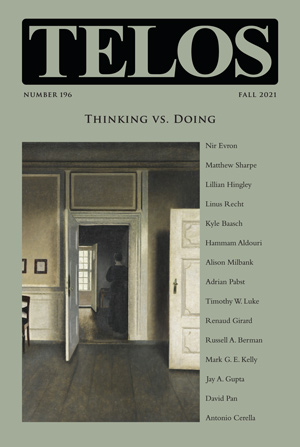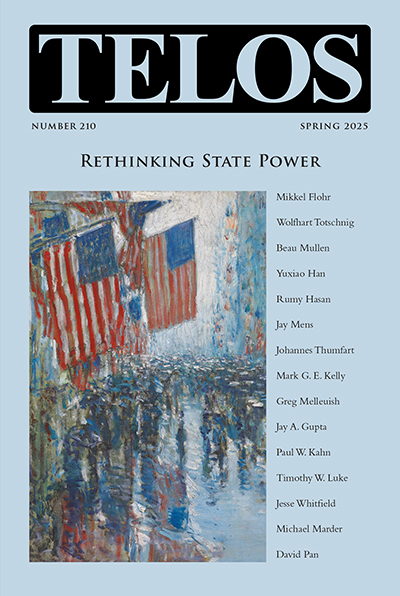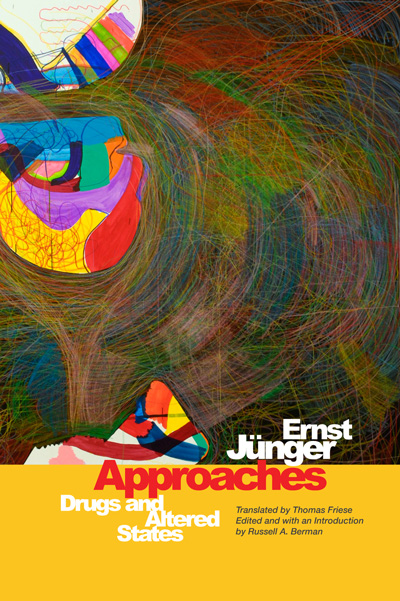In today’s episode of the Telos Press Podcast, David Pan talks with Matthew Sharpe about his article “Solitaire/Solidaire: Camus, Contemplation, and the Vita Mixta” from Telos 196 (Fall 2021). An excerpt of the article appears below. In their conversation they discussed the ways Albert Camus engaged himself politically during his life; how Camus justified his aesthetic work in relation to his political activity; how he responded to critiques of his focus on contemplation rather than political engagement; and how he understood the relationship between aesthetic contemplation and philosophical contemplation. If your university has an online subscription to Telos, you can read the full article at the Telos Online website. For non-subscribers, learn how your university can begin a subscription to Telos at our library recommendation page. Print copies of Telos 196 are available for purchase in our online store.
Solitaire/Solidaire: Camus, Contemplation, and the Vita Mixta
Matthew Sharpe
But it is not the same thing, I think, the life of a contemplative philosopher as that of a statesman…
—Plutarch, Life of Pericles, 16:6
 Albert Camus’s short story “Jonas, or The Artist at Work” was originally drafted in 1953 as “La Vie d’artiste.”[1] The published story, included in 1957’s Exile and the Kingdom, dramatizes the rise and fall of a Parisian painter. Both the story’s title and its biblical epitaph recall the book of Jonah. Having had success with early paintings, Jonas buys a small Parisian apartment with large vertical windows, suggesting the ribs of Jonah’s whale, which is soon filled with a host of admirers who come to dote upon the new sensation. Jonas spends his days in the main room trying to paint, a baby in one hand, the constantly ringing telephone nearby, and hangers-on everywhere. In spare moments, he struggles to answer a growing correspondence of petitioners. Soon, Jonas finds himself expected to comment on all of the issues of the day, with “Just as you say” becoming his compliant mantra.[2]
Albert Camus’s short story “Jonas, or The Artist at Work” was originally drafted in 1953 as “La Vie d’artiste.”[1] The published story, included in 1957’s Exile and the Kingdom, dramatizes the rise and fall of a Parisian painter. Both the story’s title and its biblical epitaph recall the book of Jonah. Having had success with early paintings, Jonas buys a small Parisian apartment with large vertical windows, suggesting the ribs of Jonah’s whale, which is soon filled with a host of admirers who come to dote upon the new sensation. Jonas spends his days in the main room trying to paint, a baby in one hand, the constantly ringing telephone nearby, and hangers-on everywhere. In spare moments, he struggles to answer a growing correspondence of petitioners. Soon, Jonas finds himself expected to comment on all of the issues of the day, with “Just as you say” becoming his compliant mantra.[2]
Eventually, the time to practice his art escapes Jonas. Then, imperceptibly, his passion falters (as he puts it, his “star” deserts him). Jonas turns to drink, has affairs, and frequents working-class bars, as far from his pretentious disciples as possible. He tries painting cloudscapes, which no one buys. His disciples disappear, and his critics multiply. At last, Jonas conceives a new, great work. He procures wood, hammer, and nails, and he builds a stairway into his loft, where, one story above the crowd, with the inner strength finally to say, “Don’t bother, I’m working,” he shuts himself off for two days in the dark, “sitting there waiting, with his palms up, on his knees.” Then he collapses. The doctor diagnoses a case of overwork. Meanwhile, in the next room, Jonas’s friend Rateau surveys the large canvas Jonas had been working on in the loft. It is completely blank except for a single, tiny word reading, indiscernibly, either solitaire or solidaire, whence our title here.[3]
“Jonas, or The Artist at Work” represents a thinly veiled satire on Camus’s own life in the early 1950s, as Herbert R. Lottman and others have noted.[4] After the overwhelming success of L’Étranger and La Peste, the demands on the author-philosopher’s time had grown exponentially. This was the period of the littérature engagée announced by the opening edition of Les Temps modernes (1945) and championed by Jean-Paul Sartre.[5] Camus the outsider from colonized Algeria, now based in metropolitan France and a veteran of the resistance, was engaged in urgent political debates and campaigns, signing petitions, and answering invitations to speak, act, or write on the revelations of Soviet crimes, Spain, Greece, Vietnam, the Cold War, Algeria, Tunisia, the future of France, the fate of Europe, and more.[6] The biblical epitaph from Jonah with which Camus frames his 1953 fable bespeaks the author’s increasing sense of losing control of his time and life: “Take me up and cast me forth into the sea, for I know that for my sake this great tempest is upon you.”[7]
Underlying “Jonas, or The Artist at Work,” however, there is also a more general issue with which Camus wrestled throughout his life. This is the ancient issue of the tension between the active and public versus the leisured and contemplative life, the vita activa versus the vita contemplativa. This issue is today most widely known through Hannah Arendt’s chef d’oeuvre, The Human Condition.[8] Arendt famously argues that modern culture is characterized by the loss of not one but two existential possibilities that the ancient Greeks and Romans had enshrined. The first is the vita activa of the engaged citizen, debating with others in democratic ekklesia or republican assemblies. The second, lesser remarked, is the contemplative life of the philosophers devoted to theoria and the pursuit of knowledge of unchanging truths, in different stages of withdrawal from public life; a form of life that would be inherited and transformed within Christianity by the competing monastic traditions, whose devotees withdrew from worldly commitments to give themselves over to the pursuit of God.[9] Interestingly, Arendt principally cites Saint Thomas’s defense of the vita contemplativa from the Summa Theologica, at the height of the Christian medieval world, in order to explain this today largely lost form of life.[10] But Aquinas brings together Aristotle’s arguments in Nicomachean Ethics concerning the putatively superior, more enduring satisfactions to be achieved through contemplation of eternal truths, with references to the lineage of Christian monasticism beginning with Saint Benedict and Saint Gregory, to make his case for the superiority of the contemplative, monastic life over the life of worldly activity.[11]
Our framing claim here will be that Camus saw the vocation of the artist, both in its receptivity to beauty and in its necessary, leisured preconditions, as a modern avatar of the vita contemplativa. In this way, his work pushes against Arendt’s diagnosis of the complete loss of any sense of this possibility of life among the moderns. Indeed, Camus defended the vocation of the artist in just these terms. He admired the act of artistic creation as a kind of ethically exemplary one, both for the personal discipline it calls forth from the artist and in its task of bearing witness to all of the different dimensions of human experience, not excluding the most intimate experiences of grief, loss, friendship, wonder, and love. This vocation of the artist Camus accordingly saw as a profoundly necessary counter to all post-Hegelian philosophies in later modernity that ask us to assent to the view that all aspects of human Geist are wholly “historical” or political.
Camus ought therefore to be numbered, this essay will argue, as one of the few thinkers of the last century who, while not advocating for a wholesale contemplative withdrawal he deemed impossible in the twentieth century, sought to preserve a sense of the merits and necessity of otium. Ultimately, he would advocate for what he calls a “right to solitude” in a fully human society, and in any full human life.[12] Camus made his case for a revindication of the necessity of leisure most directly in his ongoing philosophical reflections on art, once more a comparatively understudied aspect of his oeuvre, but one that is at the heart of L’Homme révolté in particular.[13] What emerges above all in Camus’s post-1945 writings on art, we will argue, is an advocacy, in the light of the pervasive demands of sociopolitical realities on moderns’ lives, for a restoration of what in the ancient world was called the vita mixta (mixed life of activity and contemplation).
Part 1 of the paper examines Camus’s encounters with, and sympathetic responses to, different historical avatars of the vita contemplativa. The focus here is, first, on Camus’s ongoing engagements with classical Greek thought and culture as a counterbalance to modern, post-Hegelian historicisms. Second, we examine the analysis of Camus’s conception of “the life of the artist” in The Myth of Sisyphus, as exactly such a modern form of the vita contemplativa, which responds to the absence of the theological-metaphysical presuppositions of earlier forms of this way of life. Part 2 then turns to Camus’s mature, postwar philosophy of artistic creation in The Rebel and “Creating Dangerously,” his Nobel Prize address, in detail. In the dialectic between forms of realism and formalism that these aesthetic texts stage, what we find is Camus’s sustained, mature reflection on the limits, place, and need for contemplative modes of activity in a good life. Complete withdrawal from society for the individual, he argues, is no more possible or responsible in later modernity than the artistic retreat into purely formalistic experiments. Yet, at the same time, forms of art that are wholly shaped and preoccupied by the political concerns of the times are no more finally adequate than totalizing forms of political government that allow their citizens no private realm in which to explore those dimensions of experience and sociability that transcend political affairs.
Continue reading this article at the Telos Online website. If your library does not yet subscribe to Telos, visit our library recommendation page to let them know how.
1. See Albert Camus, “The Life of the Artist: A Mimodrama in Two Parts,” trans. Ryan Bloom, New Yorker, August 9, 2013, https://www.newyorker.com/books/page-turner/the-life-of-the-artist-a-mimodrama-in-two-parts. Cf. English Showalter, Jr., “The Artist at Work: An Ironic Self-Portrait,” in Exile and Strangers: A Reading of Camus’s Exile and the Kingdom (Columbus: Ohio State Univ. Press, 1984), pp. 89–106; Showalter, “Camus and Dadelsen’s ‘Jonas,'” Modern Language Studies 12, no. 2 (1982): 41–47; Marie-Thérèse Blondeau, “D’un chute l’autre,” in Albert Camus, l’artiste, ed. Sophie Bastien et al. (Cerisy: Presse universitaire de Rennes, 2015), pp. 56–70; and for comparison of the two texts, Emmett Parker, Camus: The Artist in the Arena (Madison: Univ. of Wisconsin Press, 1966), pp. 143–45.
2. Albert Camus, Exile and the Kingdom, trans. Justin O’Brien (London: Penguin, 1962), p. 92.
3. Ibid., p. 115.
4. For an account of this time in Camus’s life, see Herbert R. Lottman, Camus: A Life (New York: Doubleday, 1979), pp. 467–520, esp. ch. 38, “Jonas”; cf. Showalter, “The Artist at Work.”
5. See Jean-Paul Sartre, “Qu’est-ce que la littérature?” (Paris: Gallimard, 1948); cf. Judith Emery Bruneau, “La littérature engagée,” Québec français 131 (2003): 68–70. Camus would in December 1957 challenge the notion of “commitment,” suggesting that the intellectual is now “impressed” into political engagement. See Albert Camus, “Create Dangerously,” in Resistance, Rebellion, and Death: Essays, trans. Justin O’Brien (New York: Vintage Books, 1960), pp. 249–50.
6. See Camus’s letter to “P.B.” in February 1953, in which we read Camus defending himself against his admirer’s charge of “haughty solitude,” saying that “such a quality, if it existed, would be a blessing for me,” given his multiple commitments at this time. Albert Camus, Lyrical and Critical Essays, ed. Phillip Thody, trans. Ellen Conroy Kennedy (New York: Vintage, 1987), pp. 342–43.
7. Jonah 1:12. Cf. Camus, Exile and the Kingdom, p. 83.
8. Hannah Arendt, The Human Condition (Chicago: Univ. of Chicago Press, 1958).
9. Ibid., pp. 12–17. On monastic forms of life, see esp. Jean Leclerq, The Love of Learning and the Desire for God (Fordham, NY: Fordham Univ. Press, 1982). In the Greek, the leisure involved in such withdrawal from the sociopolitical world is scholia, whence the English “scholarship”; in Latin, it is the life of otium, against which—as in the Greek, for instance in Aristotle’s Politics 7.15.13334a22–25—the active life is demarcated negatively, as a privation of this positive possibility: negotium/ascholia.
10. Arendt, The Human Condition, pp. 15n12, 16n13.
11. Aquinas, Summa Theologica, II, 2, q.182, art. 1–8. Different models of the vita contemplativa are to be found in the classical world, from Epicurean to Neoplatonic, as well as in Renaissance figures led by Petrarch and Ficino. See Paul A. Lombardo, “Vita Activa versus Vita Contemplativa in Petrarch and Salutati,” Italica 59, no. 2 (1982): 83–92; Brian Vickers, “Leisure and Idleness in the Renaissance: The Ambivalence of Otium,” Renaissance Studies 4, no. 1 (1990): 1–37.
12. Albert Camus, Oeuvres complètes, 4 vols. (Paris: Gallimard, 2006–2008), 2:494.
13. But see, relatively recently, the articles in Bastien et al., Albert Camus, l’artiste.



